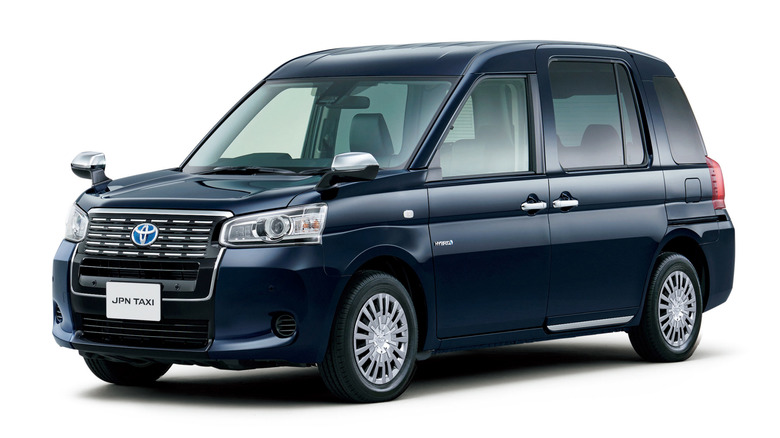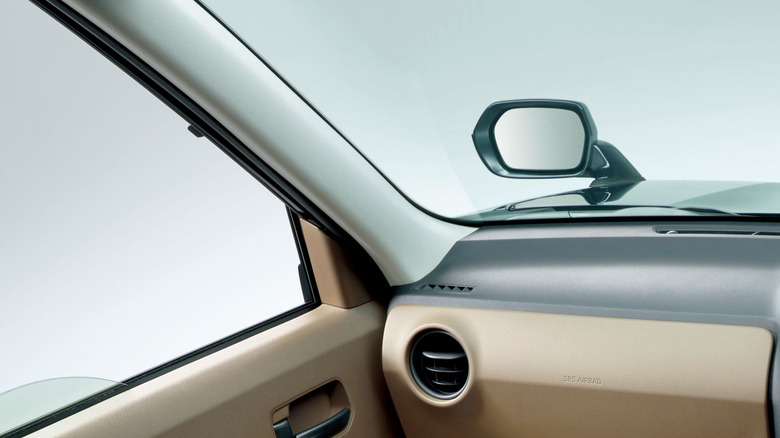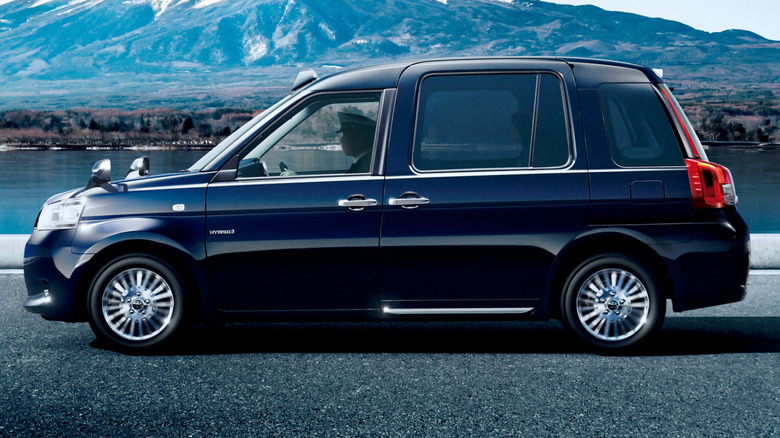Why Did Japanese Cars Have Mirrors On The Hood?
The world of JDM is a microcosm of passionate automobile fans and car-tuning wizardry. After all, it has given us icons like the Nissan Skyline GT-R, Mazda RX-7 FD, and the gorgeous Honda NSX. Yet, the history of Japanese cars is also brimming with engineering oddities. One of them is the trend of fender mirrors, or wing mirrors. Essentially, instead of the door, the mirrors were mounted on the hood. A few brands used to kit their commercial cars with fender mirrors in Japan, and you can still find them on taxis in the country.
But what purpose did they serve? Well, taxi drivers — the biggest adherent group — cite improved visibility as the key reason. They are said to minimize blind spots for drivers. Japan's parking problems are well-known, thanks in no part to densely populated locales and space-constrained street parking avenues. Mirrors mounted on the hood don't protrude as much from the sides attached to the car's doors, thereby offering better maneuverability on narrow lanes and packed traffic scenarios.
Since crowded roads are a daily reality for cab drivers in Japan, it's pretty obvious why they would prefer fender mirrors. Carmakers are well aware of this preference, as well. When Toyota introduced the JPN Taxi in 2017, the company highlighted the remote-controlled power hood mirrors. "This model offers the driver an optimal range of vision, in part through innovations to the position and shape of the pillars and the use of fender mirrors," said the company.
Safety and privacy
When it comes to fender mirrors on vehicles, the debate is mostly centered on cars and the aesthetic debate around them. But it seems government agencies have also been paying close attention to the role of fender mirrors, even on larger vehicles such as trucks. "Trucks without a right fender mirror may be significantly overinvolved in crashes," says a study published by the University of Michigan.
Another study published in the Society of Automotive Engineers (SEA) Mobilus journal mentions that for expert drivers, door and fender mirrors don't make a huge difference in their response times, but for novice drivers, the latter is recommended because door mirrors lead to a longer response time. This study was also cited by the National Highway Traffic Safety Administration (NHTSA) in an 88-page report discussing crash incidents.
According to the Japanese national daily, Sankei Shimbun, fender mirrors would cost a significantly higher amount to manufacturers to modify and replace compared to the standard door-mounted design. The likes of Nissan and Suzuki have abandoned the trend, while Toyota only fits them on cars intended for taxi rides. There are a few exceptions, however, such as the Toyota Land Cruiser 70, which was launched in Japan last year.
Fender mirrors are also deemed more private, as they reduce the chances of eye contact between the driver and passenger, avoiding the "looking at you" scenario. With fender mirrors, drivers don't have to turn their heads in the direction of the passenger seat due to the expanded field of view they offer.
Why did fender mirrors fade away?
According to Japan Times, which cites an expert at the Japan Automotive Manufacturers Association, fender mirrors were mainstream on the local cars up until 1983. It was a local motor vehicle regulation to have one, or a pair. But after the norms were relaxed, cars with door-mounted mirrors slowly became mainstream due to customer preference for the design. Apparently, it wasn't due to any aesthetic nuisance or technical woes, but due to the aspirational value attached to cars made by foreign labels.
"Door mirrors had become the norm in the Western market, and foreign car-makers argued that Japan's refusal to recognize side-door mirrors amounted to a non-tariff trade barrier," wrote the outlet. Eventually, due to the shifting market dynamics, brands slowly phased out wing mirrors. Moreover, as local labels such as Toyota started selling the Western markets, they had to embrace the trend of door-mounted mirrors. And it seems all mirrors will become a thing of the past as new technologies with a deeper functional appeal land on the scene.
In 2016, following an amendment to the UN's auto regulations, Japan's transportation ministry greenlit the idea of cars without rear-view and side-view mirrors. Instead, the cars will come equipped with a camera-based position monitoring system to bolster driver safety. A year later, BMW showcased its vision of a mirror-less car, and Japan's Mitsubishi is exploring the idea, as well. Nuro's self-driving delivery vehicles also miss out on side mirrors and embrace a camera-based system.


